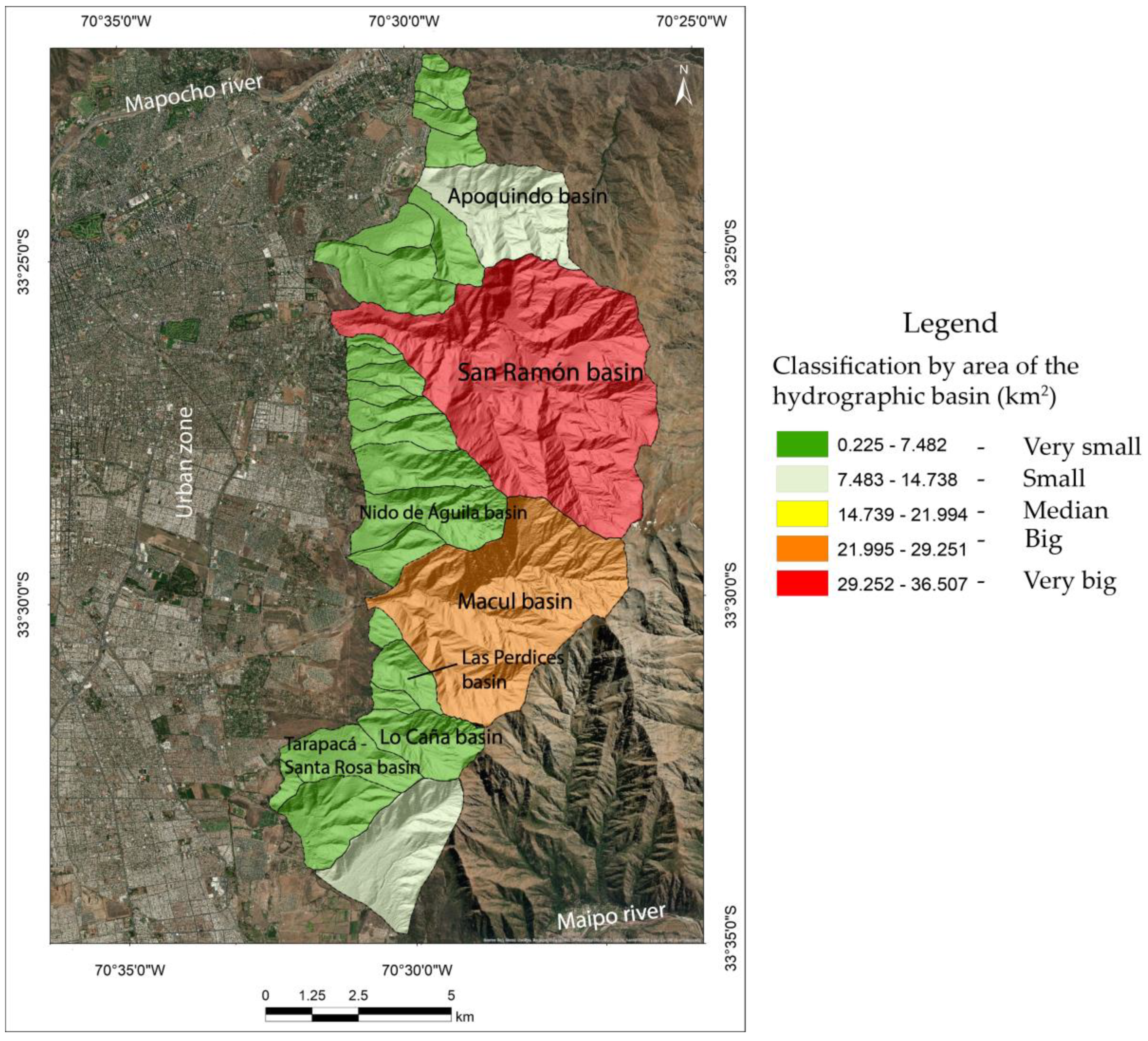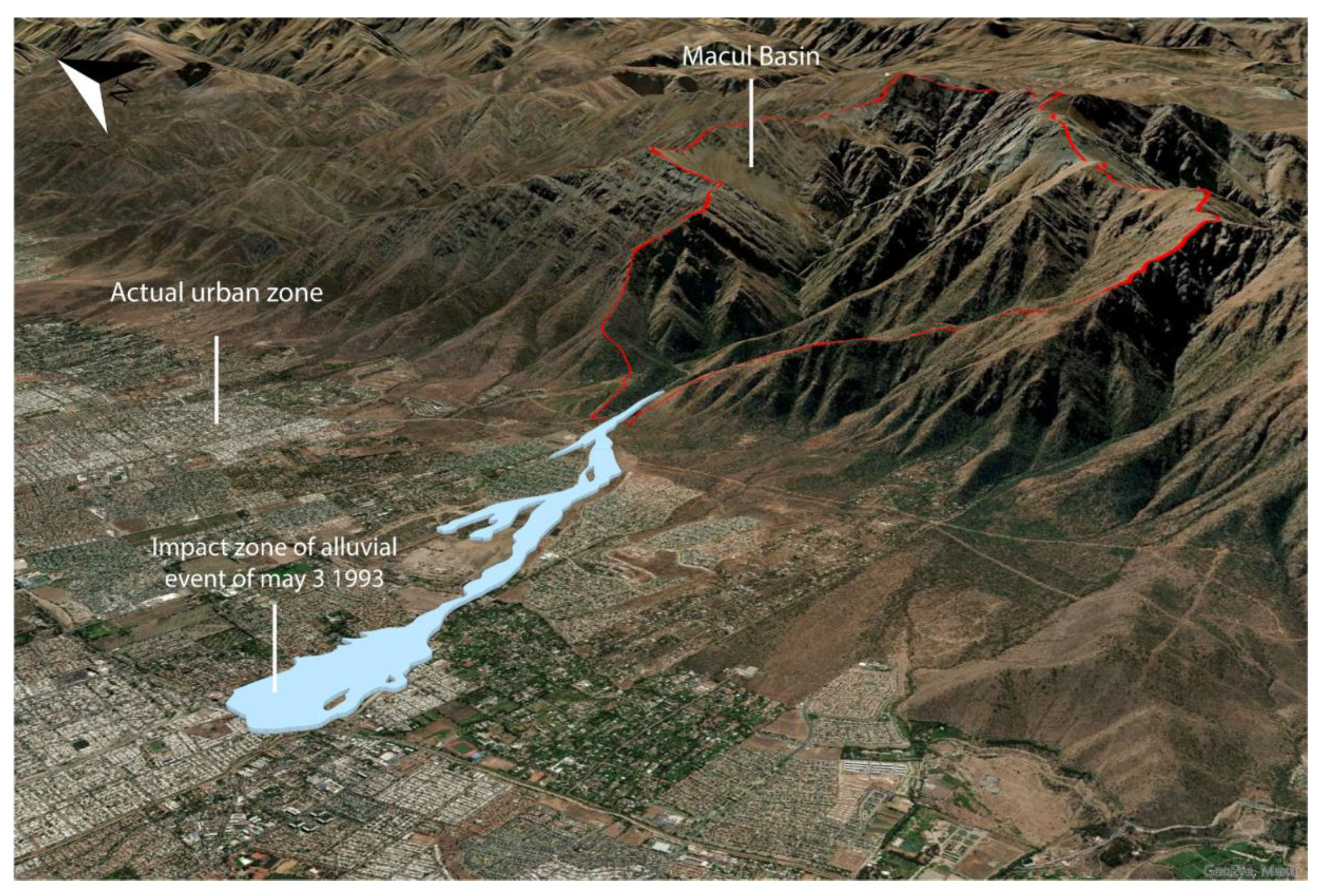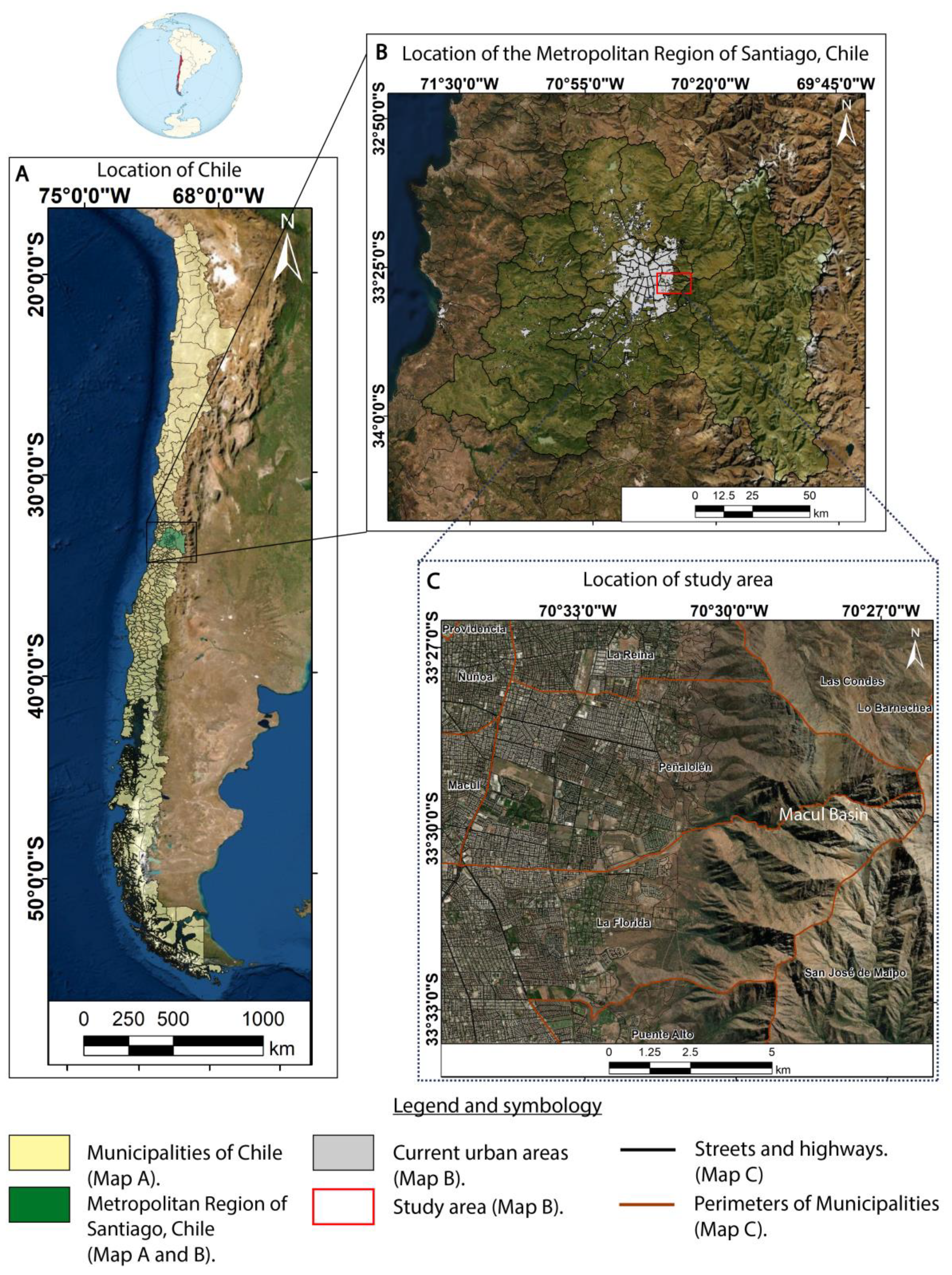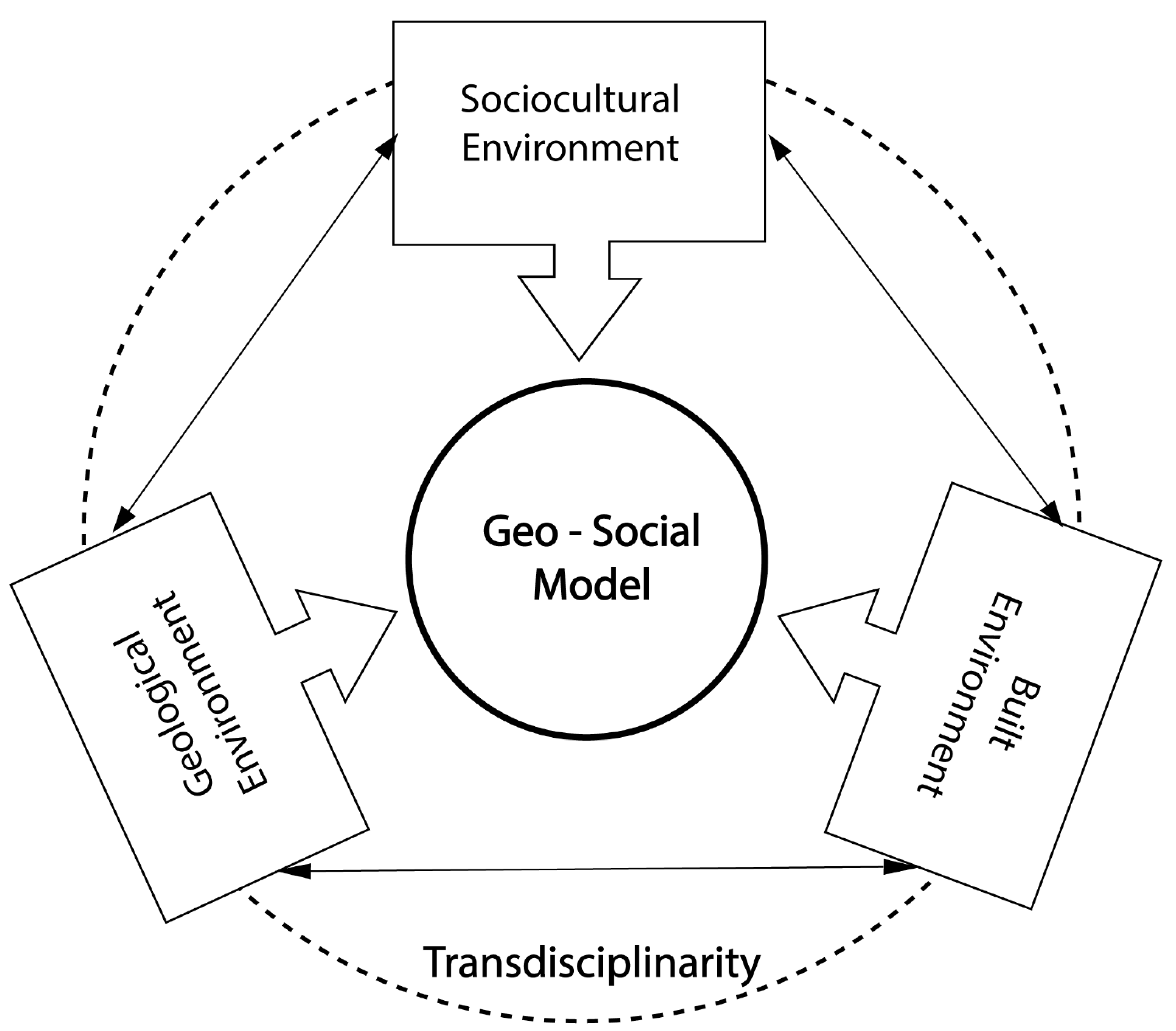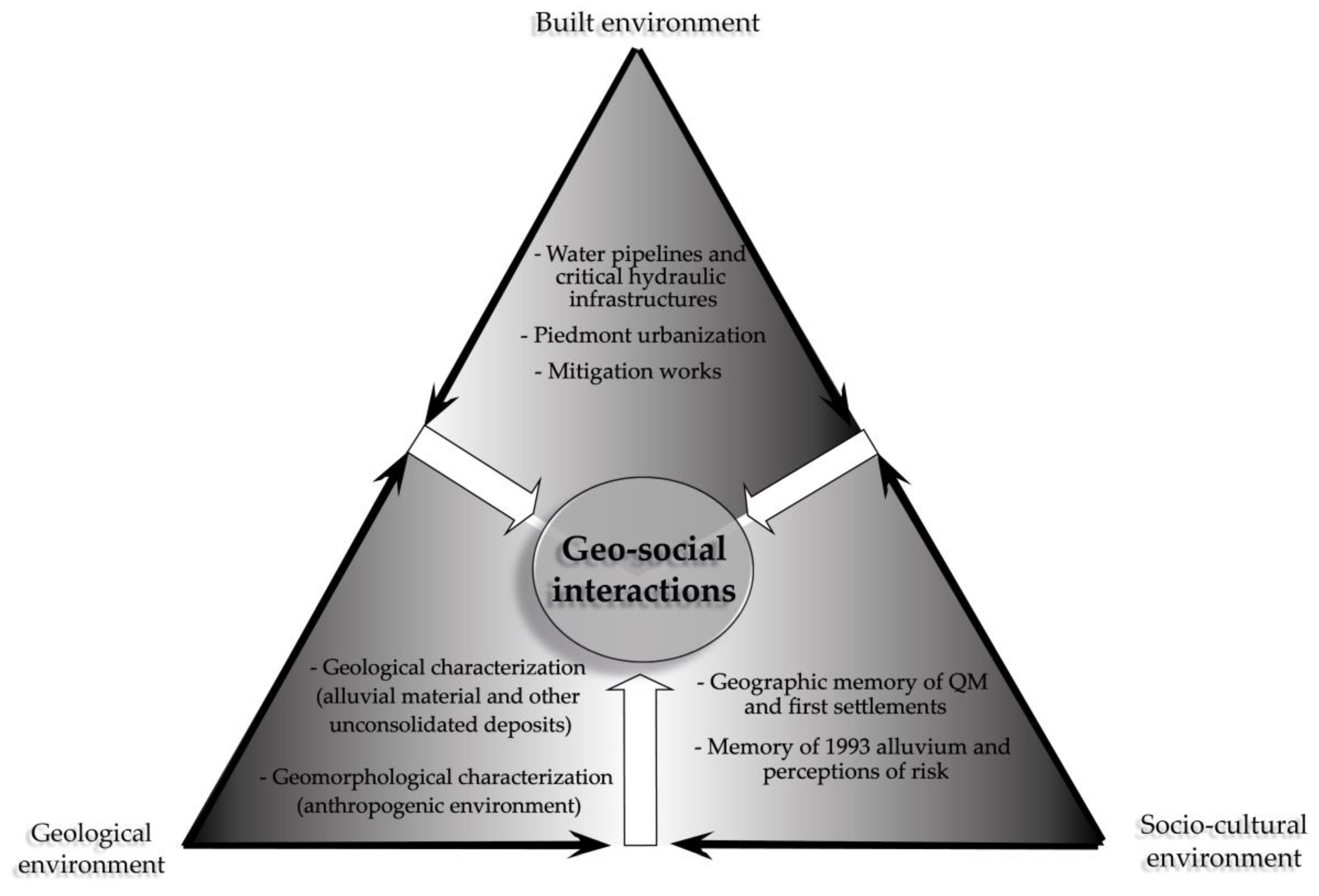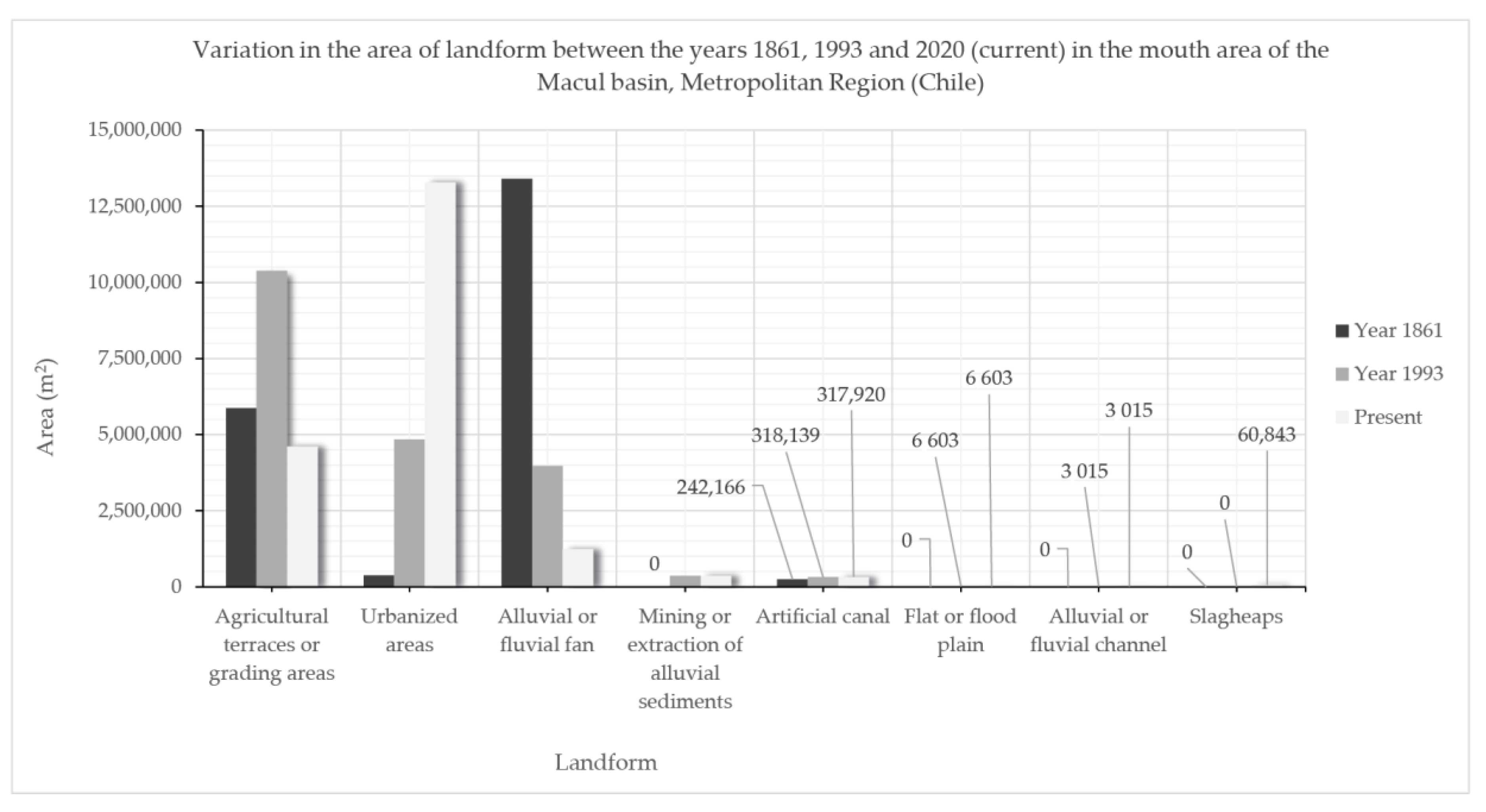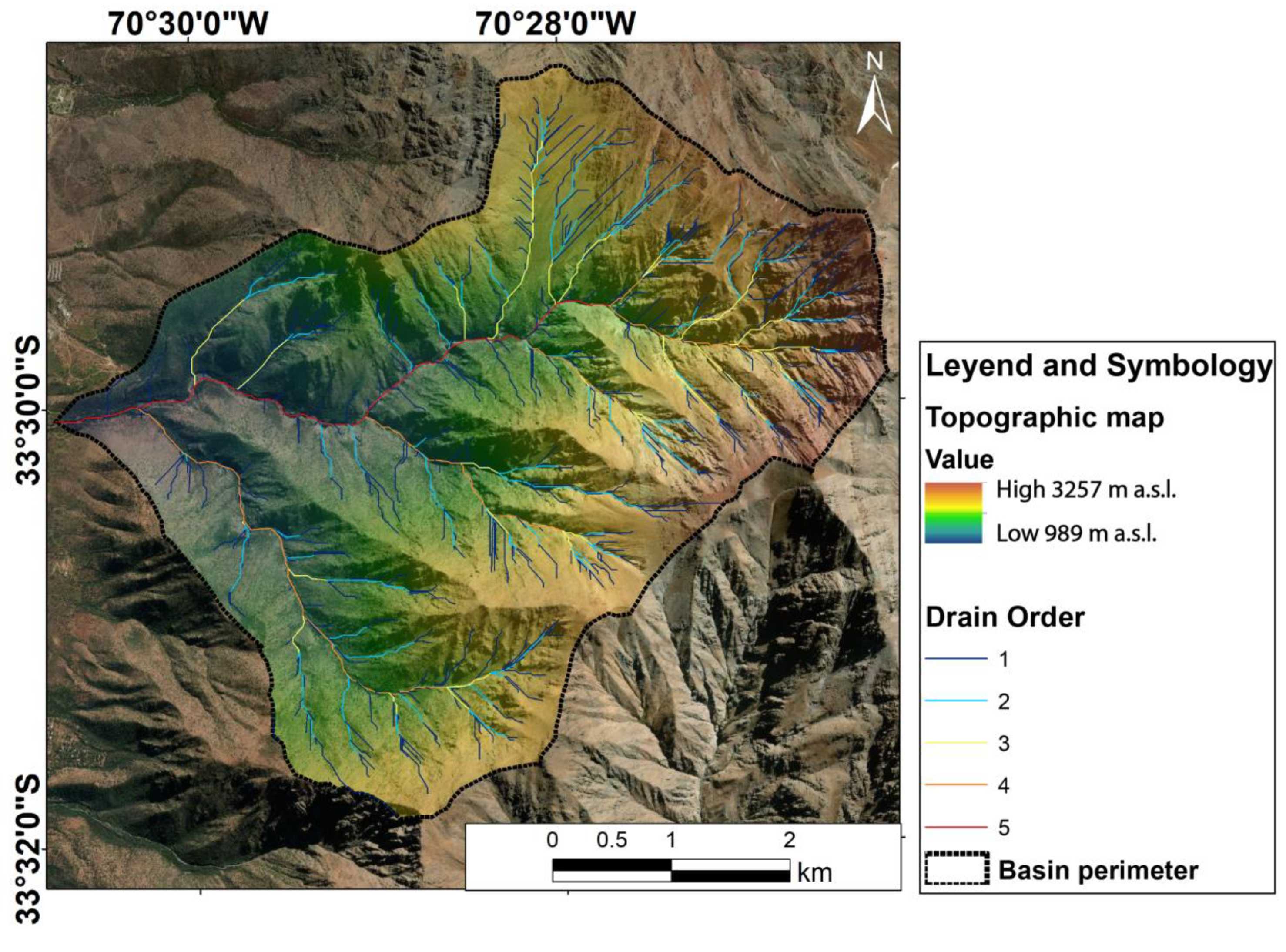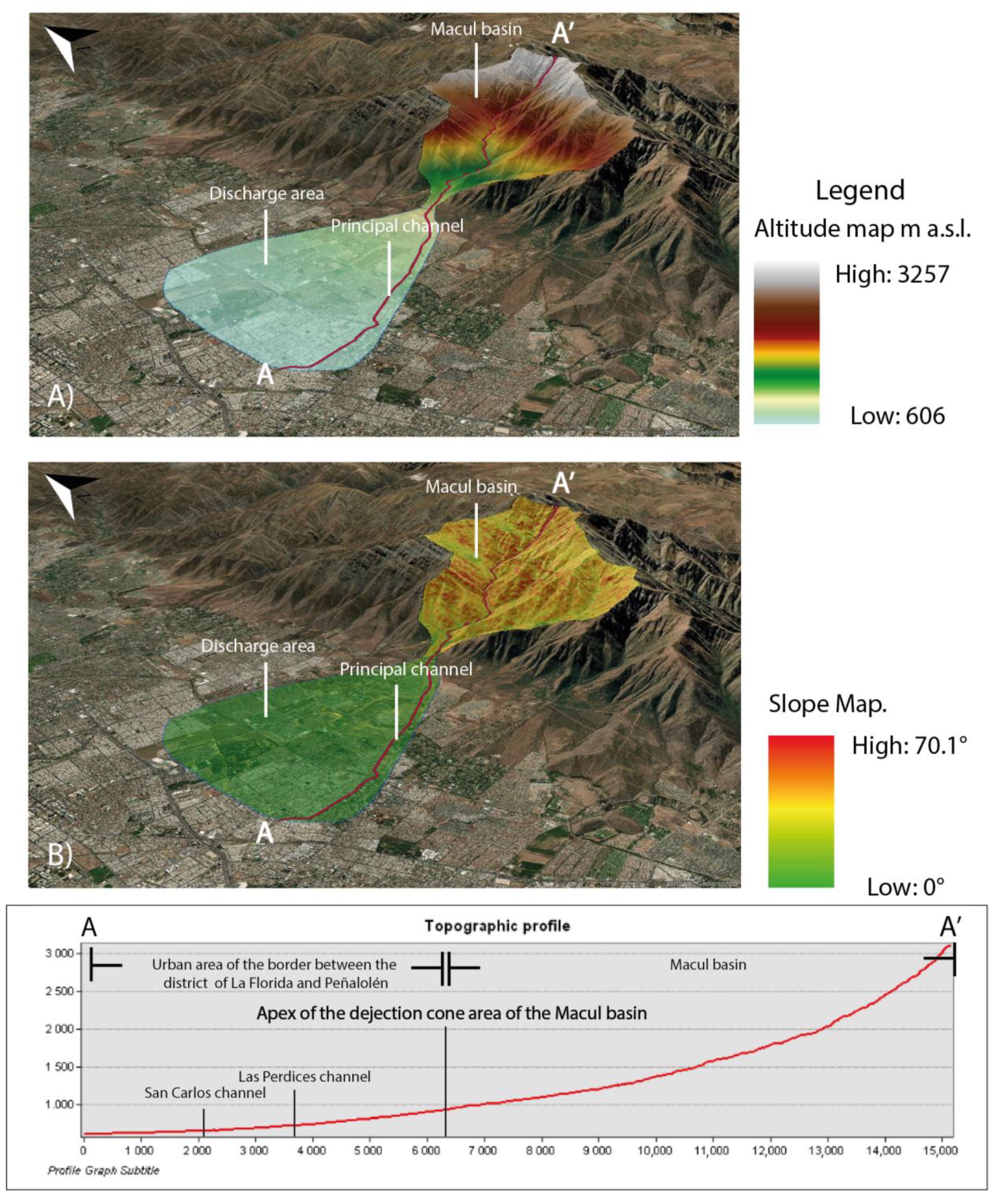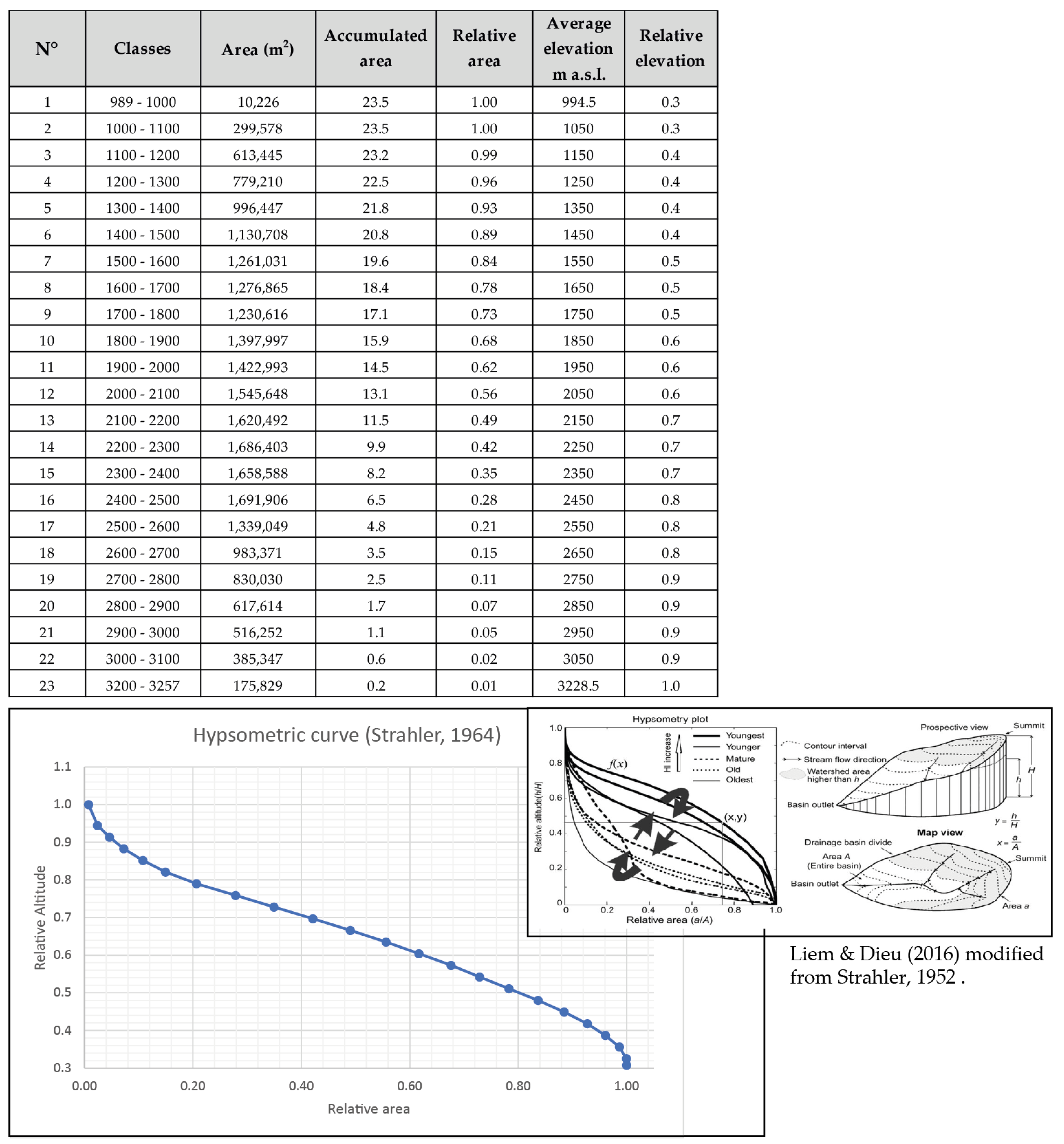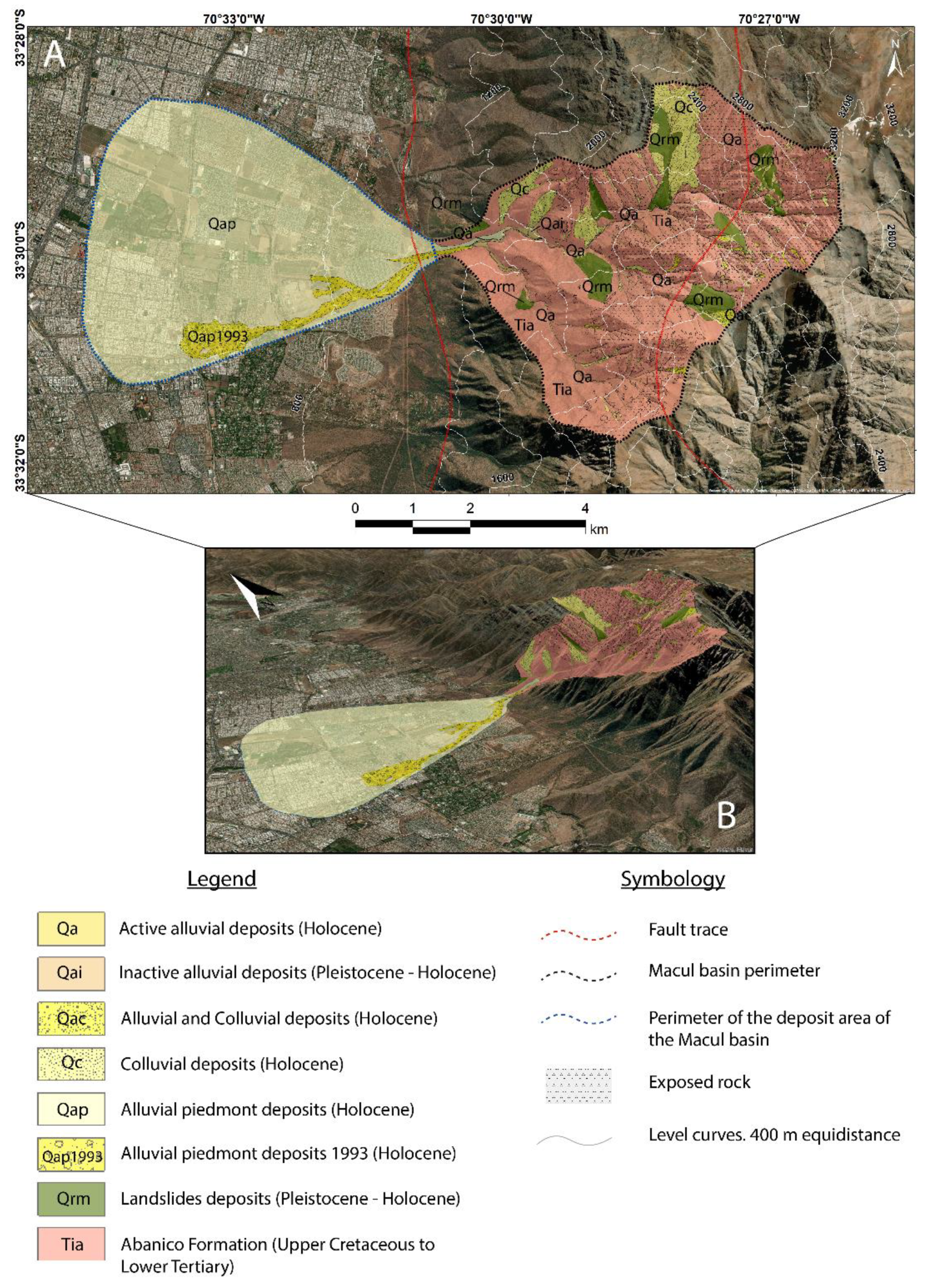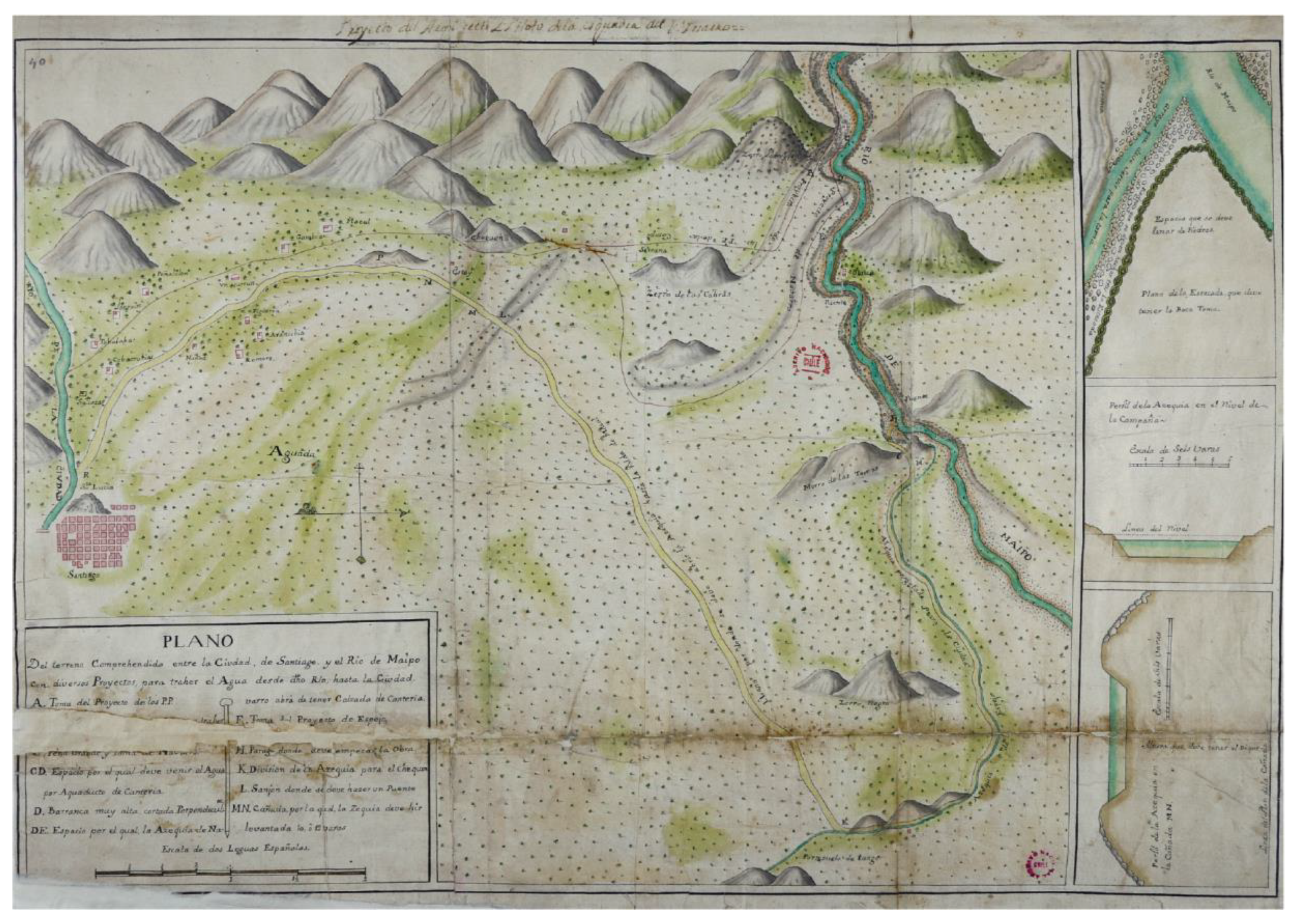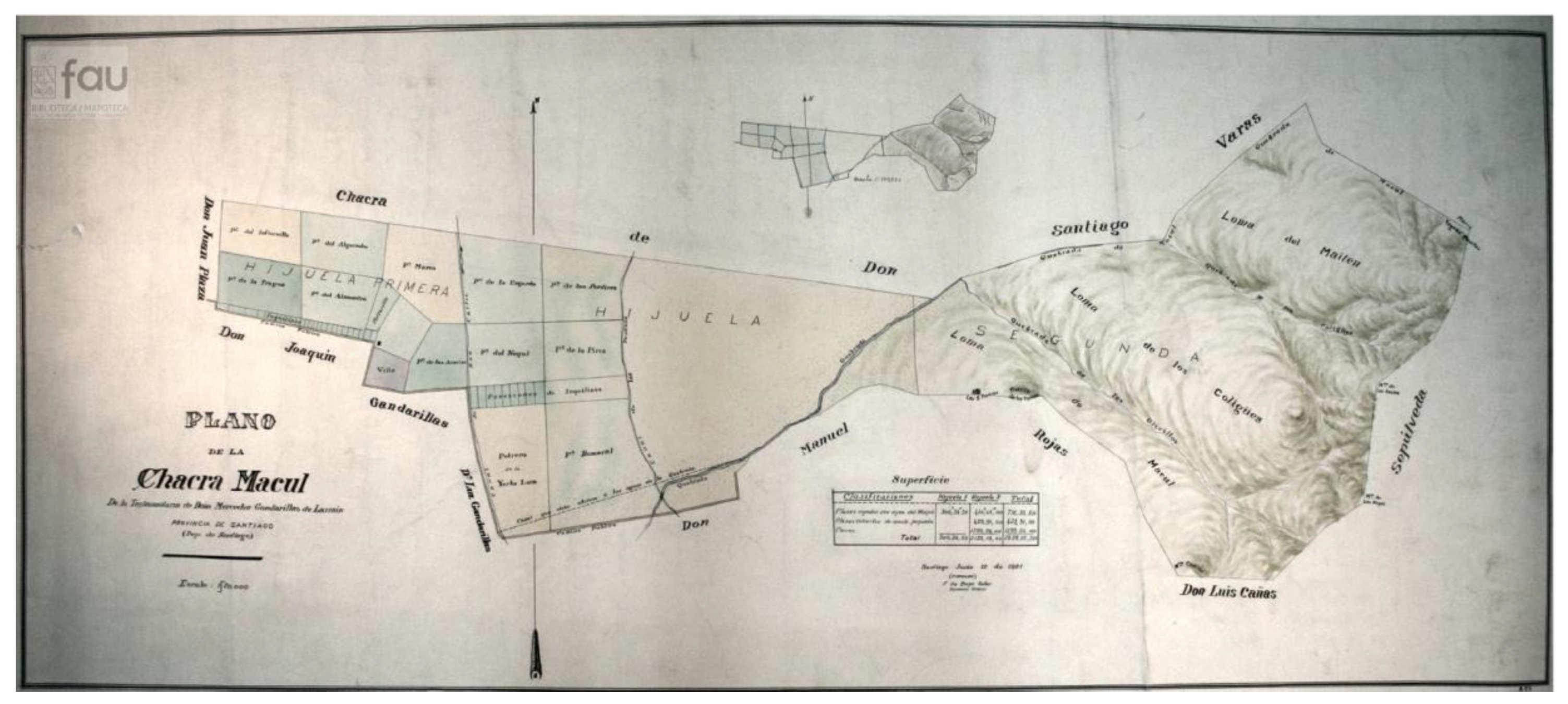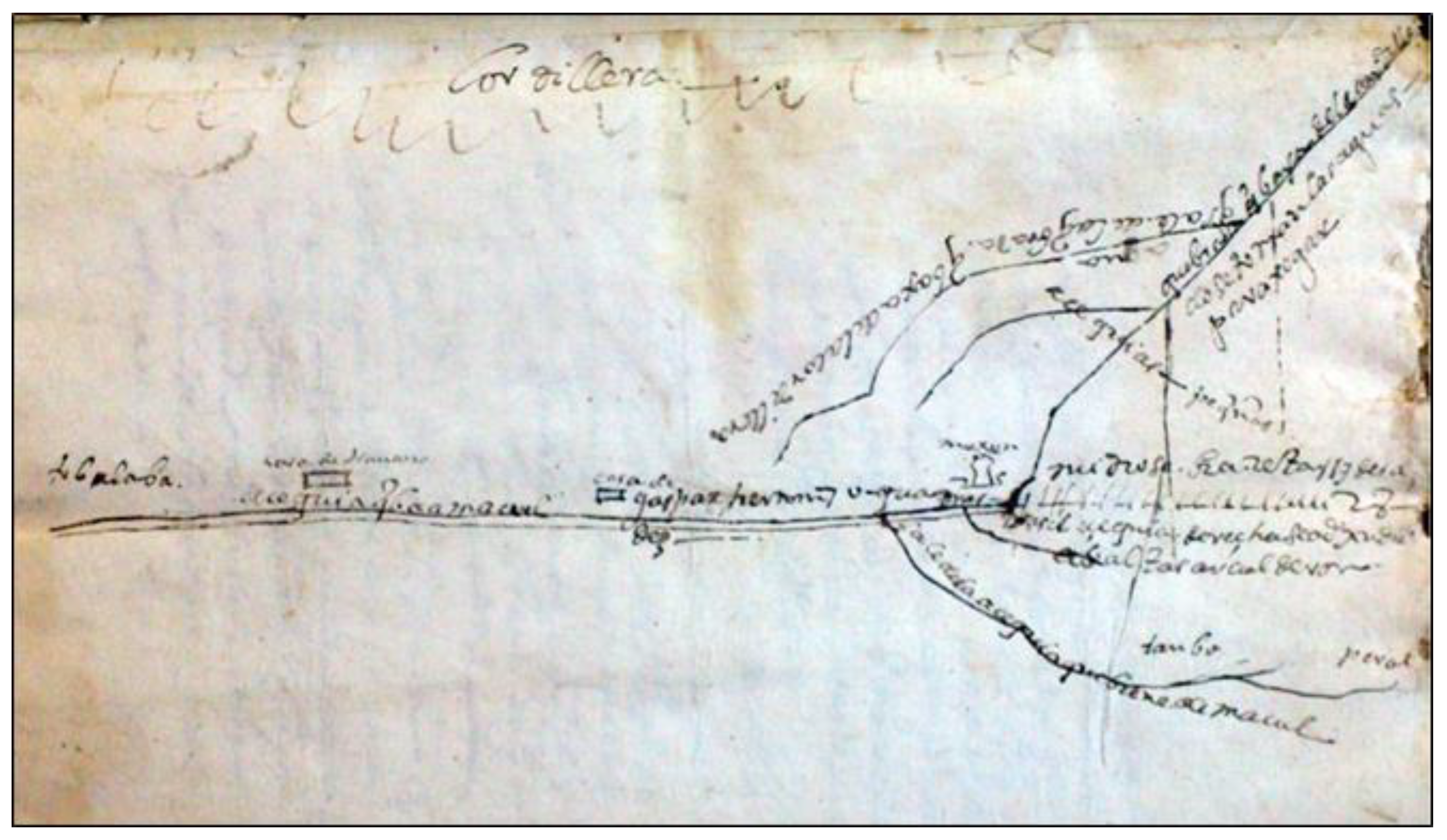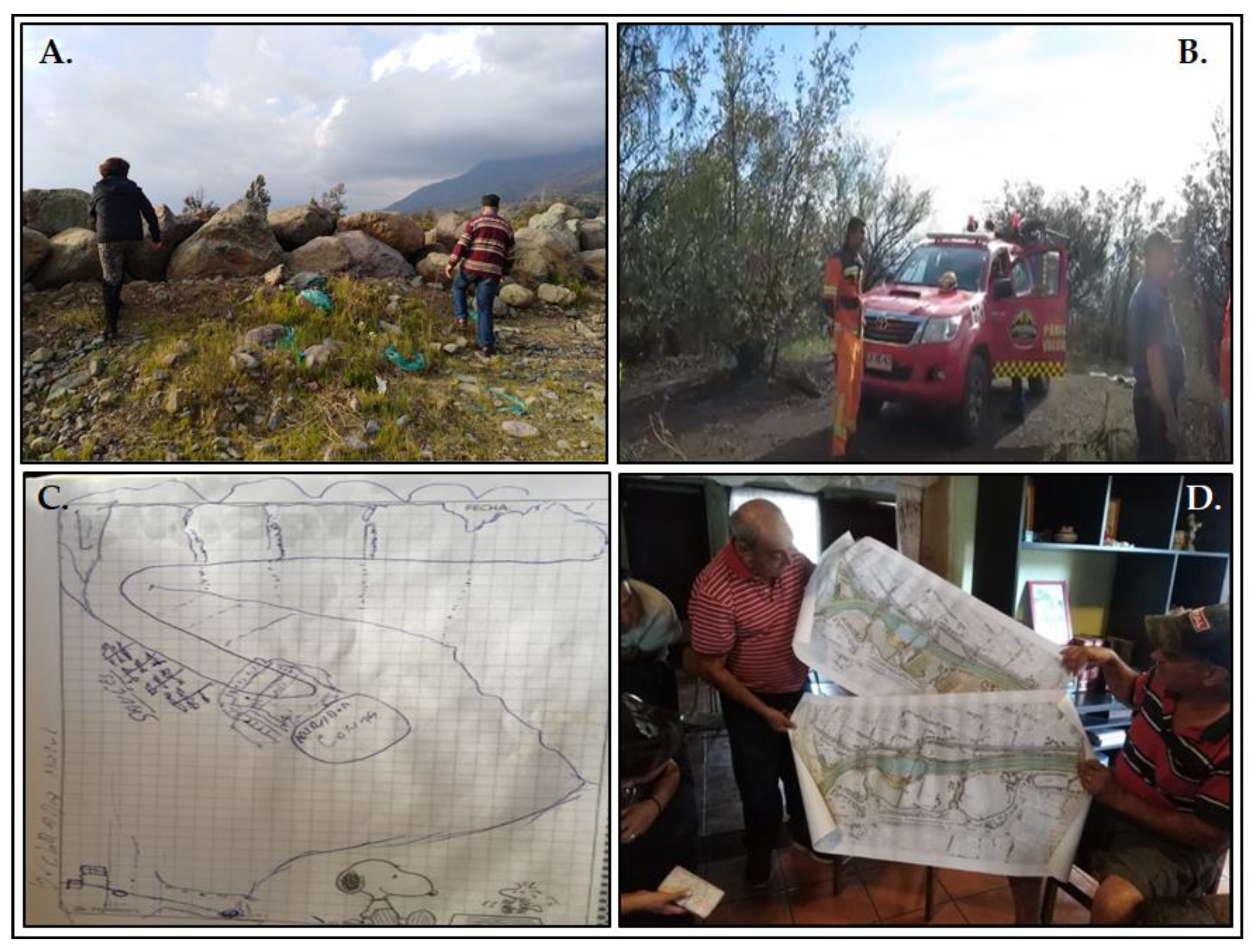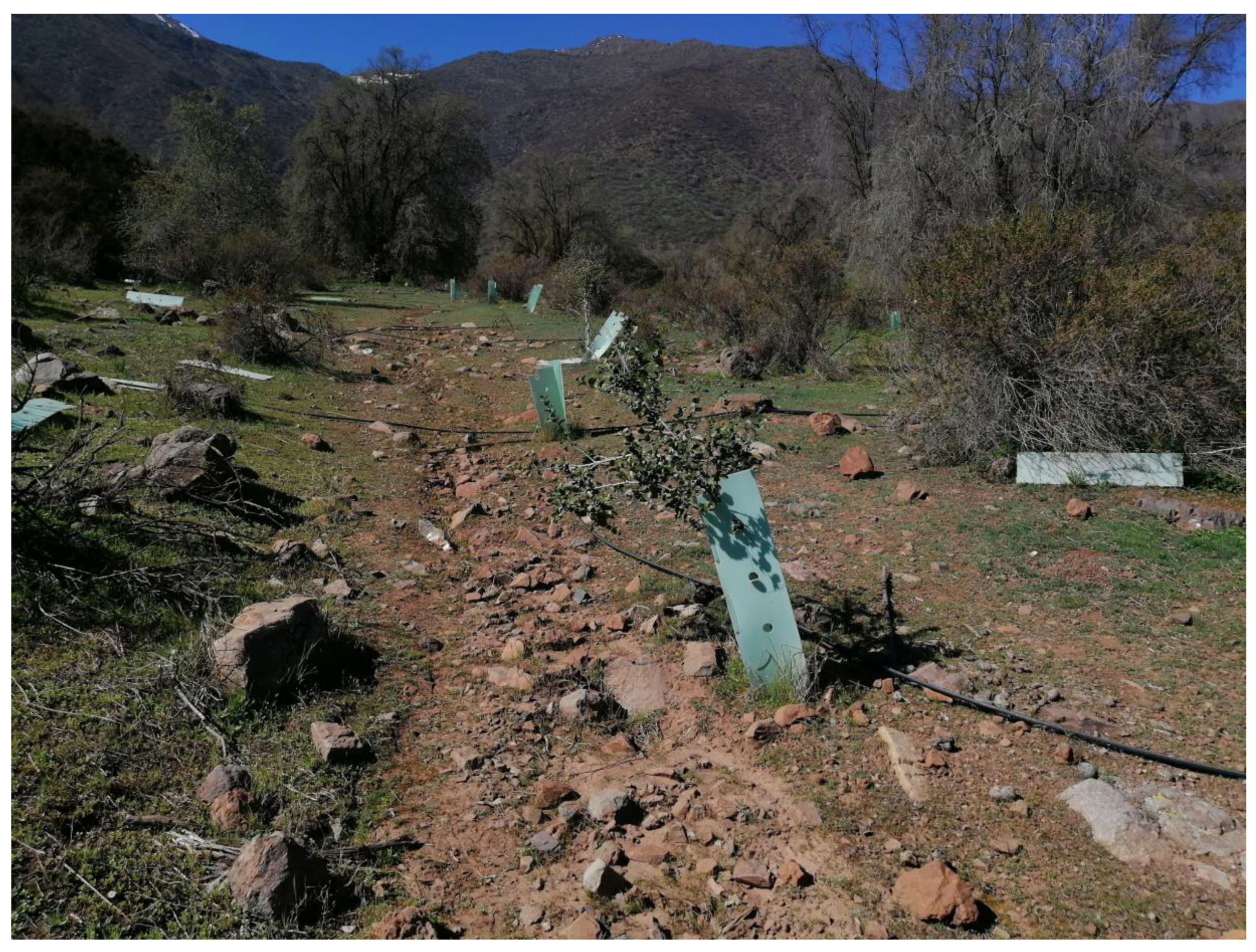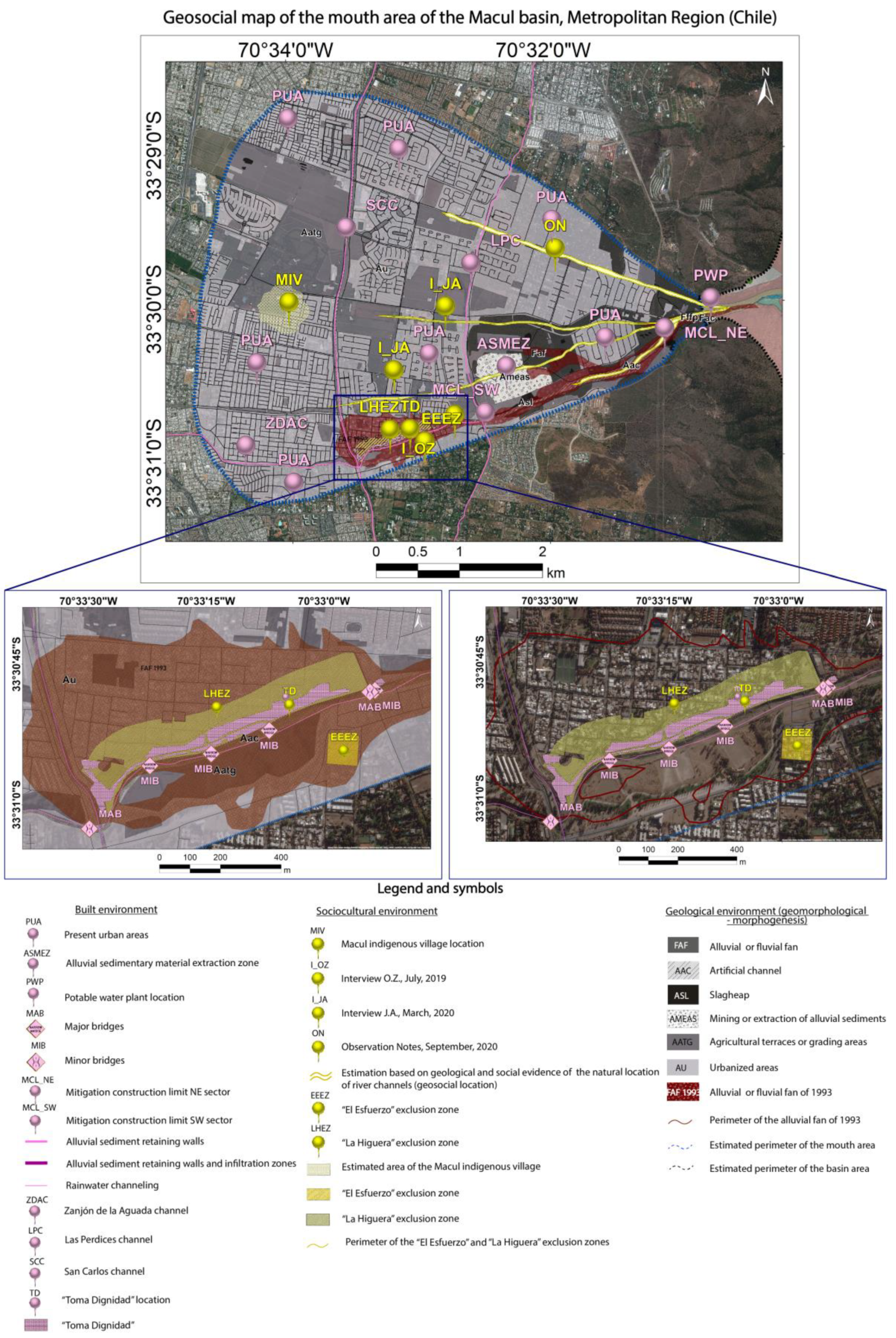1. Introduction
Landslides (Landslides will be described according to the classification of Cruden, D. & Varnes, D.J., 1996) will increase worldwide [
1]. Due to growing urbanization, continuing deforestation and augmenting precipitations related to climatic pattern variability are intensifying landslide events [
2,
3,
4], affecting particularly socioeconomically vulnerable exposed communities in urban areas [
5,
6,
7]. In the case of Chile, mass flows constitute one of the greatest geological threats in urban areas, with considerable human losses; this has been explained in developing countries as a consequence of higher poverty rates, more corrupt governments, and weaker healthcare systems [
6,
8]. In particular, the Metropolitan Region—where Quebrada de Macul is located—is one of the areas with the highest periodicity of landslide events in the last 30 years [
9]. In fact, from 1908 to the present there have been 12 alluvial events [
9] including on of the worst national catastrophes since the 1950s: The flow of 3 May 1993 in Quebrada de Macul (henceforth QM).
That morning, intense rainfall, high temperatures, and a zero-degrees isotherm at 2000 m a.s.l. combined, generating the perfect conditions for debris flow and mudflow. The result was a mass removal event of different pulses of debris and mud flow with accumulated material of 6.5 × 10
5 and 1 × 10
6 m
3, and with a deposit thickness reaching more than 3 m in the axis of the stream composed of silt, sand, and blocks of up to 3 m in diameter, in addition to eucalyptus trunks and anthropogenic debris. It should be noted that the first flow began at 11:40 am with a debris flow of up to 1 m high, reaching speeds of up to 15 km/h, and 30 km/h in the second pulse developed 10 min later, directly impacting the urban area, destroying houses, trucks, sheds, trunks, etc. The consequence was the devastation of urban areas along the ravine in the districts of La Florida and Peñalolén in the metropolitan area of Santiago (
Figure 1). The disaster left 26 deaths, 8 missing, 85 injured, and more than 30,000 people affected. In addition, 307 houses were destroyed and another 5610 were severely damaged [
10].
The memory of these events is still present in the community today, standing as a major sociocultural marker in affected neighborhoods [
10]. Since the catastrophe, the area has undergone intense demographic transformations, including rapid urbanization and gentrification processes [
11]. This has not reduced, however, the likelihood of a similar event today. Research has confirmed that anthropogenic modifications in the basin mouth, particularly the loss of ground waterproofing due to piedmont urbanization, directly affect the quantity and speed of water flows as well as the hydraulic characteristics of mountain sediments, configuring an important source of alluvial susceptibility [
12]. Additionally, the expected effect of climate change on the hydrometeorology of the area will likely mean a decrease in rainfall and flow levels, as well as an increase in annual temperatures [
13,
14,
15,
16]. This could have important effects on the occurrence of floods and flow-type landslides by contributing to the increase in the elevation of the 0 °C isotherm. Furthermore, as an increase in the frequency and/or intensity of warm storms is expected, these can produce runoff with high amounts of sediment in shorts periods of time.
The case of QM brings to the fore the complex interactions between hydrological, geological, infrastructural, and sociocultural processes in landslide causes and effects, particularly in the perspective of landslides prevention at the local level. It also points to the lack of integrated, transdisciplinary analyses in Chile, Latin America, and developing countries at large. Research to date has contributed to the characterization of the QM basin and its geo- and hydromorphological features [
6,
9,
17,
18,
19,
20,
21], of the history—and current processes—of the area’s territorial planning [
22], and the social imaginaries and organization around the QM disaster [
10,
23]. These research agendas, however, have remained largely unconnected, hence blocking the articulation of integrated models for participatory landslide risk management at the local level. In turn, this lack of integration has perpetuated existent and obdurate disciplinary demarcations in landslide planning [
24]. This is not uncommon in the region. There is still limited understanding about the association between geological processes and the social, economic, and cultural factors driving flow-type landslides [
4]. This integration deficit is particularly acute in contexts of weak institutional structures, as in the case of Latin America, which hamper robust and effective risk reduction initiatives [
25,
26].
This contrasts with the call made by the Agency for Integrated Risk Reduction Research and Prevention [
27,
28,
29,
30,
31]—a call reinforced by the Sendai Framework [
32] and the Global Assessment Report on Disaster Risk Reduction [
33]. As it has been suggested by these calls, a critical challenge is to provide practical solutions, education, communication, and public outreach to reduce landslide disaster risk, to which end transdisciplinary involvement, knowledge co-production, and process-oriented and territorially embedded initiatives are fundamental components [
24,
33,
34]. This implies, first and foremost, a substantive epistemological shift in the way that geohazards are understood, analyzed, and intervened. As argued by Alcántara-Ayala [
24] (p. 155), “most of the work on landslides has been undertaken from a discipline-focused approach, especially in the physical, earth sciences and engineering fields. To a lesser extent, investigations have been carried out from a social science perspective, whereas Integrated Research on Landslide Disaster Risk is practically non-existing”. This may be caused, as Matsura and Razak [
35] (p. 5) suggest, because “hazard science is still predominantly conducted in a traditional framework of basic geosciences in which scientists do not feel the responsibility to translate knowledge into actions”.
To fill this gap, in this paper we develop what we call the Geo-Social Model: a systematic attempt at integrating diverse knowledges for assessing and acting upon complex geoclimatic events. The Geo-Social Model aims at integrating geological and social analyses for flow-type landslide reduction and planning, while also incorporating local communities as fundamental scientific and political actors. Drawing on the case of QM, the Geo-Social Model therefore is, we suggest, a research device, a policy tool, and an epistemological proposition.
The reminder of the paper is organized as follows. We first describe our analytical framework and methodological approach to the QM case. Second, we apply the Geo-Social Model through a transdisciplinary approach. Third, we identify the interactions between geological, planning, and social processes and visualize them via a geo-social map. Finally, we discuss our results with the broader literature. While we apply the model to the QM case, we suggest that the Geo-Social Model—by identifying and analyzing the connections of the above-mentioned processes—offers a robust tool to (a) understand the complex phenomenology of the landslides than impact in urban zones, (b) integrate the community in disaster risk reduction initiatives, and (c) connect scientific research to policy making in diverse contexts.
4. Geo-Social Model: Mapping Environmental Interactions in the Macul Basin
As an exploratory methodology that seeks to render visible, through transdisciplinary processes, the interactions between the geological, built, and socio-cultural environments, the Geo-Social Model can be translated into a geo-social map of the Macul Basin (
Figure 17). This map, as an exercise in making the complexities of the territory public, contributes to a better understanding of the alluvial phenomenon, and hence emerges as a relevant conceptual and methodological tool for landslide risk reduction and prevention in the future.
The geo-social map (
Figure 17) shows and synthesizes an evident intersection between the three environments. The estimated perimeter of the mouth of the alluvium—that is part of the geological environment—overlaps with the built environment because it is mostly urbanized (PUA and AU) except for the few agricultural and grading areas that remain in the area (AATG). In addition, as we already showed, the artificial channel Zanjón de la Aguada (ZDAC) intercepts perpendicularly with the two main water channels of the study area—Canal Las Perdices (LPC) and San Carlos (SCC)—forming the critical area of the disaster where, in effect, is the alluvial fan of the 1993 event (FAF 1993). In this area, hydraulic infrastructures identified (MAB and MIB) are critical due to the earlier connection established between the QM and the Zanjón de la Aguada, which is estimated according to historical records in the 19th century. It is also visualized that the zones of restriction or exclusion of construction (EEEZ and LHEZ) are inhabited by old houses and a recent informal settlement (TD) as evidenced by the socio-cultural environment. The zone of mining extraction (AMEAS and ASMEZ), which is part of the built environment, currently covers an area of 365,886 m
2 of the alluvial fan and can increase the detritic material of the alluvial flow and therefore its destructive power because of the unconsolidated material and its location close to the main channel. Upstream, at the apex of the river mouth, is the drinking water plant (PWP), considered as a critical infrastructure that can provide solid and liquid material, as it is exposed to the trajectory of a possible alluvial flow, due to its location and for not containing protection works.
Mitigation works (MCL_NE, MCL_SW) located in the southern zone of the mouth area, have a preferably southwestern trajectory, and form the so-called artificial channels (AAC). This particular trajectory represents a problem in terms of the lack of protection of the northern area of the alluvial fan (FAF), which in turn is made up of agricultural areas and mainly urbanized areas (AU) whose construction is relatively recent. This is because according to estimates based on geological evidence (Deposits of piedmont and alluvial fan, FAF 1993) and social evidence (Testimonies I_JA, I_OZ, ON and MIV ethnohistorical sources), the natural trajectory of the channels is possibly in a west and northwest direction, specifically along Quilin Norte street, and areas near Los Presidentes Avenue mainly coinciding with the Las Pircas neighborhood (channel geo-social location). More proof of this is the ethno-historical evidence reported by the socio-cultural environment, which indicate, based on geographical coordinates of the historical record, that the indigenous settlement of Macul (MIV) was located in the western area of the mouth of the river, coinciding with Quilin Norte street (I_JA). To this is added that the indigenous peoples used to be located in sectors bordering the natural trajectories of water, which allows us to conclude that the natural course of QM is coincident with the area mentioned above (I_JA). In other words, both the current riverbed and the mitigation works are part of a built environment that comes into conflict with the geological and socio-cultural environment of the area of study, this could lead to socio-natural disasters if are not considered in the future urban planning.
5. Discussion
Although several research studies have been developed around landslides [
52,
53,
54,
98,
99,
100,
101], there is still a need to deepen the understanding and characterization of their main conditioning and triggering factors and their in a context of anthropogenic intervention.
Based on this, from the geological discipline, several investigations have been carried out in the Macul basin, inspired mainly by the great impact on urban areas of the alluvial event of 1993 and the subsequent minor alluvial activations in the basin. For instance, Naranjo and Varela [
17] conducted a geological analysis of the causes, mechanisms, and effects of the 1993 event, inferring that the main conditioning factor was the large accumulation of unconsolidated sediments in the basin, which came from previous events deposited mainly in the alluvial channels, and inferring that the intense rainfall was the main triggering factor. However, like this research, Ayala and Cabrera [
9] indicate that the development of landslides is not only influenced by unconsolidated sediments, but also by the characteristics of other triggering factors.
The latter was the first research studying the vulnerability of certain urban areas in relation to areas possibly impacted by flow-type landslides. In this regard, Naranjo and Varela [
17] made a zoning of the 1993 impact area in Macul with field data and Garrido [
102] zoned areas for possible impacts using LAHARZ and MSF (Modified Single Direction Flow Model) algorithms, giving results relatively close to the zoning provided by Naranjo and Varela [
17]. The MSF model shows the three most probable directions for impact by flow-type landslides, which are quite close to the actualized results provided by the geo-social map. On the other hand, Martínez [
21], uses the Weighted Map Overlay methodology with the IS Susceptibility Index by applying a methodology of Lara [
58], making an advance in the application of conditioning factors, but disregarding within these the anthropogenic influence on its development.
As can be seen, although these investigations represent an important advance in the knowledge of these factors, there is still a lack of consensus in the determination of the main determinants of river landslides. However, the morphometric analysis is in a certain way complementary since it gives good results in terms of determining the response of the basin in a quantitative way, which confirms what was delivered in the geological analyses and by landform regarding the fact that the Macul basin (QM) has optimal characteristics for the development of debris flows [
56,
69,
71,
77]. In addition, its results can be used as a complementary analysis or as a qualitative method validation methodology, taking into account that the greatest weakness of this analysis is its absolute dependence on the quality of the digital elevation model, in addition to the inaccuracy of ranges inherent to any analysis.
Additionally, they tend to underestimate the anthropogenic influence in the development and magnitude of the impact of threats due to the difficulty that this entails. In this scenario, the problematization of flow-type landslides through the Geo-Social Model and a transdisciplinary approach can help to clarify this conundrum, providing advances in the way landslides are understood and assessed.
In general, even though many studies recognized the role of humans in landslide processes, there are few reviews about this topic; and conceptual and methodological problematizations [
103,
104]. Indeed, landslides are more commonly attributed to have been caused by heavy rainfall [
4], but as the results of the Geo-Social Model show, landslides—particularly in urban contexts—are often the result of anthropogenic disruptions of natural balances and systems. This is coherent with other studies carried out recently worldwide that started to conceptualize landslides as Human-Induced Landslides (IHL) that is to say, events that are “triggered or partially aggravated by anthropic activities” [
104] (p. 217).
More specifically, the results of the built and socio-cultural environment are oriented in this direction showing that anthropic activities are the result of interventions that are the effect of long histories of infrastructuring, urbanization, and occupation of the geological environment that while exceed the memory of current inhabitants, are passed intergenerationally, and registered in the material and cultural trajectories of the community and its perceptions of risk.
In first place, infrastructuring took form in QM via water canalizations that changed the natural channel for agricultural purposes in a long-term duration perspective and also through the construction of critical hydraulic infrastructures. In this regard, QM research does not point out histories of infrastructuring and its influence in landslides; from a worldwide perspective, there are few examples that account for these important triggering factors but they are coherent with the Geo-Social Model results. For example, in Belgium, Preuth et al. [
105] has shown that water pipes crossing active landslides caused deformations increasing the negative effect of water. In addition, Jaboyedoff et al. [
104] confirm that small modifications of slope topography or diversion of a surface water collector may induce landslides in many cases. Additionally, river erosion caused by modification of the course can produce landslides because it can change the course or the debris flow initiating new erosion banks which can promote landslides [
106,
107]. As Sepúlveda and Petley [
108] have argued, this lack of evidence may be explained due to a research deficit in Latin America and the Caribbean, where the mechanisms are not yet well understood, distribution causes and triggers of landslides.
Secondly, the rapid urbanization process experienced in QM evidenced occupation of hazard prone areas and pavimentation of original rural roads extending as a main regional problem has already been pointed out by national research and local organizations. The latter can be understood in low- and middle-income countries as a consequence of a badly planned and poorly managed urban expansion [
109]. In effect, it is well known that landslide vulnerability in mountain environments is increased in dense urbanization areas and/or where precarious squatter settlements have developed at the foot of slopes [
3,
4,
26,
108,
110,
111].
Thirdly, the geographic memory of QM indicates—for the first time—that its natural channel would have been located in a different place from the current one due to early anthropic modifications. Furthermore, the local memory of the event indicates the anthropogenic root—causes of the disaster, and social perceptions of risk show both the deficiencies of urban planning but also prevention strategies implemented locally as some scholars had already shown in QM in the past. This is coherent with Ullberg’s concept of ‘memory scape’ [
112,
113,
114]. In the field of social sciences, this refers to the dynamic configuration of memory in disasters, constituted by memories, forgetfulness, and reminiscences that are expressed through multiple ways, ranging from everyday practices, public documents, rituals, monuments, signs, and all kinds of physical signs that became part of disaster landscapes. As is argued by Masi [
115], this concept is a valuable input for recognition and understanding of social behaviors, which are not only gravitating as demands of explicit statements of public interventions, but essential when formulating public policies on risk management and disaster mitigation.
The geo-social map, as an experimental and exploratory tool for mapping the environmental interactions in the Macul basin (QM), is an exercise of making the aforementioned territory complexities visible and useful for the community. Even the appropriate consideration of different risk perceptions, social, political, and institutional aspects are essential for successful risk management [
116]. There is still limited experience on how technical risk analysis can be applied in areas with scarce or absent data as it happens in developing countries of Latin America, and also how it can be effectively combined with community-based risk management approaches [
117]. As a result of a transdisciplinary approach for landslides analysis and prevention, the geo-social map through a TDA approach functions as a primary tool to understand the complex geo-social characteristics of flow-type landslides and to inspire new modes of making hazard assessments in the future hand in hand with communities affected by landslides.
As Takeuchi et al. [
118] and other scholars have shown, TDA practices have not been widely exercised both in discipline and in actions. Even there are few examples worldwide that apply this approach, one of the main differences between this research and others carried out is the attempt of co-production of knowledge connecting epistemologically different disciplines and actors to create holistic approaches using concepts and methods originally created in other disciplines, to relate, integrate, bring together, synthetize, and merge them [
119]. Most examples of TDA research emerge from physical, earth sciences, and engineering fields [
24,
35], and are often applied in a top-down manner [
117].
The TDA approach of the Geo-Social Model seeks to fill this gap through the integration of epistemologically different disciplines—geology, social sciences, humanities—and the rescue of community-based resources. This is new, since TDA research carried out worldwide and in Latina America has its spotlight on science and technology stakeholders [
35] or national policy makers capabilities [
120,
121] in a general top-down manner. Despite this contribution, one of the main limitations of the research is the experimental and exploratory character of the mapping, and further research must be done in order to advance in the inclusion of geo-social features in landslides analysis and future hazard maps.
6. Conclusions
We developed what we labeled the Geo-Social Model to understand the interactions between geological processes, built interventions, and socio-cultural conditions in the formation and consequences of the 1993 landslide in Quebrada de Macul, Santiago. As an exploratory tool, this methodology brings together insights from the earth, social, planning, and engineering sciences to better understand and prevent socio-natural hazards in a process in which the community is not only the final recipient of the results, but the main actor defining the research questions, aims, and methods. While our exploration is place-dependent, we claim that as a methodology the Geo-Social Model can be adapted to other territories and communities to advance in a more integrated research in landslides.
As a way of conclusion, we want to discuss three main challenges of landslide analysis and prevention that arise from our research process. First, flow-type landslides—particularly in urban contexts—are often the result of anthropogenic disruptions of natural balances and systems. These interventions, in turn, are the effect of long histories of urbanization, infrastructuring, and occupation that, while exceeding the memory of current inhabitants, are passed intergenerationally and registered in the material and cultural trajectories of the community. If the so-called Anthropocene has been coined to call into attention the co-production of the geological and the social, then research into and intervention upon urban landslides in the Anthropocene has to account for the histories (and stories) of communities about the geological modifications of their environment.
Second, transdisciplinary approaches are critical for sustaining robust and politically. effective landslide risk prevention plans. What we learned in Quebrada de Macul is that this entails a re-accommodation of disciplinary identities. While earth scientists are required to integrate forms of evidence and narration coming from social sciences and the humanities that do not fit easily into ‘scientific’ accounts, social scientists have to engage with community demands, which usually revolve around ‘hard’ data about past and future events. Both earth and social scientists have to adapt their theories and methodologies to policy-oriented and often politically charged goals. Without the needed flexibility to meet these requirements, transdisciplinarity risks being mere tokenism, a sexy concept devoid from its epistemological and political implications.
Finally, inter- and trans-disciplinary approaches to landslide risk prevention need to be integrated into municipal-level planning. Without understanding the compound nature of landslides, and devising plans accordingly, landslides in Chile and elsewhere will continue to affect millions of people. In the case of the Global South, the lack of resources at the local level requires the implementation of ad-hoc programs at the state or federal level to channel professional and technological resources to municipalities, districts, or any other territorial subdivision. Fundamentally, it requires the empowerment of local communities to secure their substantial participation in landslide risk prevention plans: While governments often celebrate participation as arenas of encounter between communities and experts, they often forget that the first step is to create the conditions for community participation by restituting their political and territorial control.
